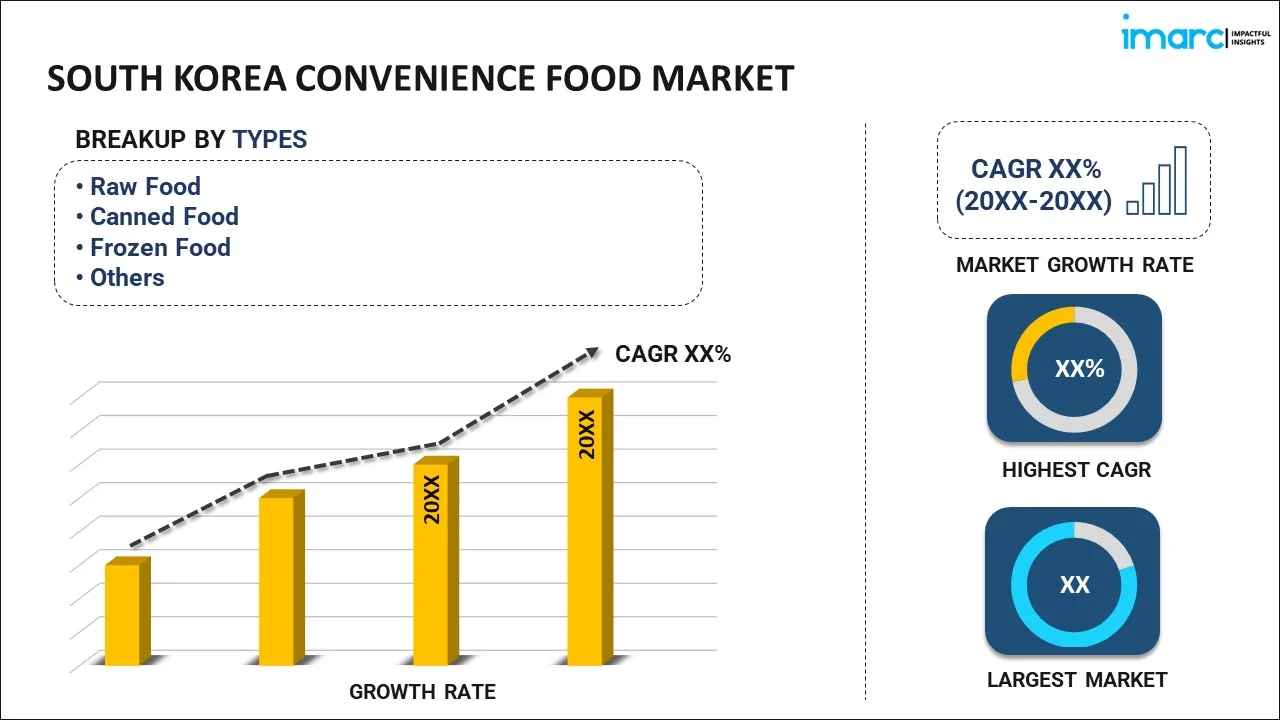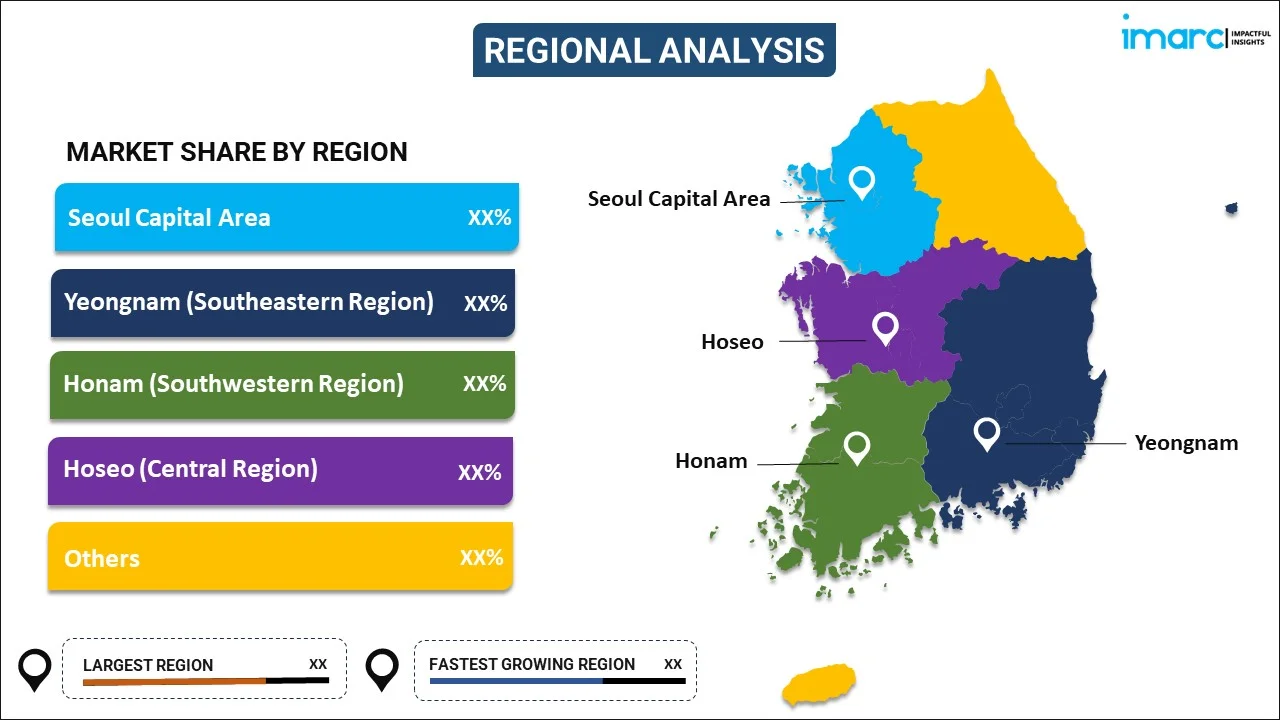
South Korea Convenience Food Market Report by Type (Raw Food, Canned Food, Frozen Food, Ready-To-Eat, Ready-To-Cook, and Others), Product (Meat/Poultry Products, Cereal-based Products, Vegetable-based Products, and Others), Distribution Channel (Supermarkets and Hypermarkets, Convenience Stores, Specialty Stores, and Others), and Region 2025-2033
Market Overview:
South Korea convenience food market size is projected to exhibit a growth rate (CAGR) of 5.50% during 2025-2033. The regional trend towards urbanization, which has led to a rise in the number of people living in urban areas where time constraints and limited cooking facilities enhance the need for convenient food options, is driving the market.
|
Report Attribute
|
Key Statistics
|
|---|---|
|
Base Year
|
2024 |
|
Forecast Years
|
2025-2033 |
|
Historical Years
|
2019-2024
|
| Market Growth Rate (2025-2033) | 5.50% |
Convenience food refers to commercially prepared or partially prepared food items that offer ease and speed in meal preparation. These products are designed to save consumers time and effort in the kitchen, catering to the demands of modern, fast-paced lifestyles. Common examples include frozen meals, canned soups, pre-packaged snacks, and instant noodles. Convenience foods often undergo processes such as pre-cooking, freezing, or dehydration to extend shelf life and maintain quality. While they provide convenience, they may also raise concerns about nutritional value and the presence of additives. Despite potential drawbacks, convenience foods have become integral to contemporary diets, offering a quick solution for individuals with hectic schedules or limited culinary skills. The evolution of convenience food reflects societal changes, including the rise of dual-income households and the growing need for convenient, on-the-go sustenance in an increasingly fast-paced world.
South Korea Convenience Food Market Trends:
The convenience food market in South Korea is experiencing robust growth, primarily driven by shifting consumer lifestyles and preferences. Changing demographics, coupled with the increasing number of dual-income households, have propelled the demand for quick and convenient meal options. Additionally, the pervasive influence of urbanization has led to time constraints, prompting consumers to seek hassle-free solutions in their hectic schedules. Furthermore, the rising awareness of health and wellness has spurred the demand for convenient yet nutritious food choices, aligning with the contemporary emphasis on well-balanced diets. Moreover, advancements in food processing technologies and packaging innovations have played a pivotal role in enhancing the convenience food sector. The surge in e-commerce platforms has made these products more accessible, providing consumers with the convenience of doorstep delivery. The regional health crisis further accelerated the adoption of convenience foods as consumers sought hygienic, ready-to-eat options. Collectively, these interconnected factors continue to drive the convenience food market in South Korea, shaping its trajectory in response to the evolving demands of modern lifestyles.
South Korea Convenience Food Market Segmentation:
IMARC Group provides an analysis of the key trends in each segment of the market, along with forecasts at the regional and country levels for 2025-2033. Our report has categorized the market based on type, product, and distribution channel.
Type Insights:

- Raw Food
- Canned Food
- Frozen Food
- Ready-To-Eat
- Ready-To-Cook
- Others
The report has provided a detailed breakup and analysis of the market based on the type. This includes raw food, canned food, frozen food, ready-to-eat, ready-to-cook, and others.
Product Insights:
- Meat/Poultry Products
- Cereal-based Products
- Vegetable-based Products
- Others
A detailed breakup and analysis of the market based on the product have also been provided in the report. This includes meat/poultry products, cereal-based products, vegetable-based products, and others.
Distribution Channel Insights:
- Supermarkets and Hypermarkets
- Convenience Stores
- Specialty Stores
- Others
The report has provided a detailed breakup and analysis of the market based on the distribution channel. This includes supermarkets and hypermarkets, convenience stores, specialty stores, and others.
Regional Insights:

- Seoul Capital Area
- Yeongnam (Southeastern Region)
- Honam (Southwestern Region)
- Hoseo (Central Region)
- Others
The report has also provided a comprehensive analysis of all the major regional markets, which include Seoul Capital Area, Yeongnam (Southeastern Region), Honam (Southwestern Region), Hoseo (Central Region), and Others.
Competitive Landscape:
The market research report has also provided a comprehensive analysis of the competitive landscape. Competitive analysis such as market structure, key player positioning, top winning strategies, competitive dashboard, and company evaluation quadrant has been covered in the report. Also, detailed profiles of all major companies have been provided.
South Korea Convenience Food Market Report Coverage:
| Report Features | Details |
|---|---|
| Base Year of the Analysis | 2024 |
| Historical Period | 2019-2024 |
| Forecast Period | 2025-2033 |
| Units | Billion US$ |
| Scope of the Report | Exploration of Historical Trends and Market Outlook, Industry Catalysts and Challenges, Segment-Wise Historical and Future Market Assessment:
|
| Types Covered | Raw Food, Canned Food, Frozen Food, Ready-To-Eat, Ready-To-Cook, Others |
| Products Covered | Meat/Poultry Products, Cereal-based Products, Vegetable-based Products, Others |
| Distribution Channels Covered | Supermarkets and Hypermarkets, Convenience Stores, Specialty Stores, Others |
| Regions Covered | Seoul Capital Area, Yeongnam (Southeastern Region), Honam (Southwestern Region), Hoseo (Central Region), Others |
| Customization Scope | 10% Free Customization |
| Report Price and Purchase Option | Single User License: US$ 3699 Five User License: US$ 4699 Corporate License: US$ 5699 |
| Post-Sale Analyst Support | 10-12 Weeks |
| Delivery Format | PDF and Excel through Email (We can also provide the editable version of the report in PPT/Word format on special request) |
Key Questions Answered in This Report:
- How has the South Korea convenience food market performed so far and how will it perform in the coming years?
- What has been the impact of COVID-19 on the South Korea convenience food market?
- What is the breakup of the South Korea convenience food market on the basis of type?
- What is the breakup of the South Korea convenience food market on the basis of product?
- What is the breakup of the South Korea convenience food market on the basis of distribution channel?
- What are the various stages in the value chain of the South Korea convenience food market?
- What are the key driving factors and challenges in the South Korea convenience food?
- What is the structure of the South Korea convenience food market and who are the key players?
- What is the degree of competition in the South Korea convenience food market?
Key Benefits for Stakeholders:
- IMARC’s industry report offers a comprehensive quantitative analysis of various market segments, historical and current market trends, market forecasts, and dynamics of the South Korea convenience food market from 2019-2033.
- The research report provides the latest information on the market drivers, challenges, and opportunities in the South Korea convenience food market.
- Porter's five forces analysis assist stakeholders in assessing the impact of new entrants, competitive rivalry, supplier power, buyer power, and the threat of substitution. It helps stakeholders to analyze the level of competition within the South Korea convenience food industry and its attractiveness.
- Competitive landscape allows stakeholders to understand their competitive environment and provides an insight into the current positions of key players in the market.
Need more help?
- Speak to our experienced analysts for insights on the current market scenarios.
- Include additional segments and countries to customize the report as per your requirement.
- Gain an unparalleled competitive advantage in your domain by understanding how to utilize the report and positively impacting your operations and revenue.
- For further assistance, please connect with our analysts.
 Inquire Before Buying
Inquire Before Buying
 Speak to an Analyst
Speak to an Analyst
 Request Brochure
Request Brochure
 Request Customization
Request Customization




.webp)




.webp)












